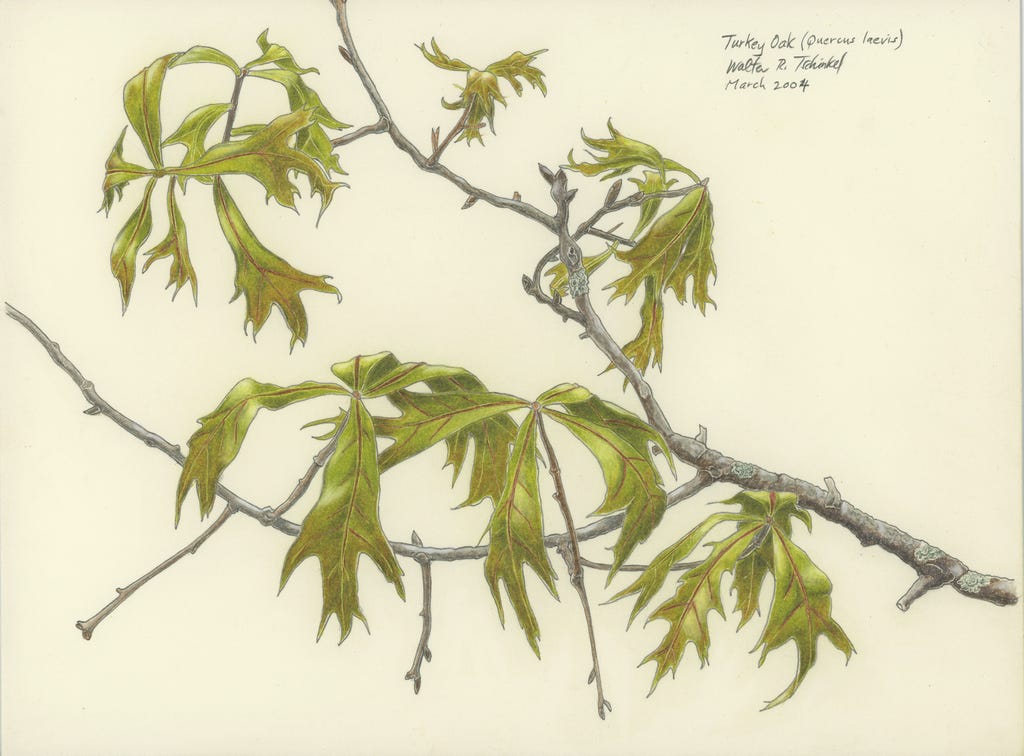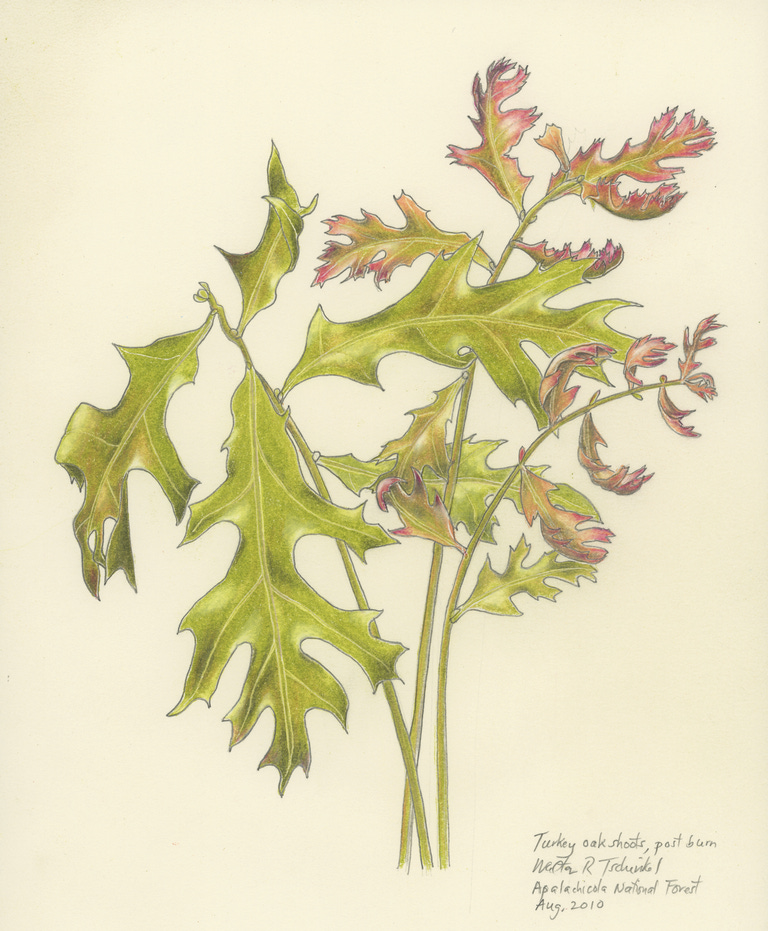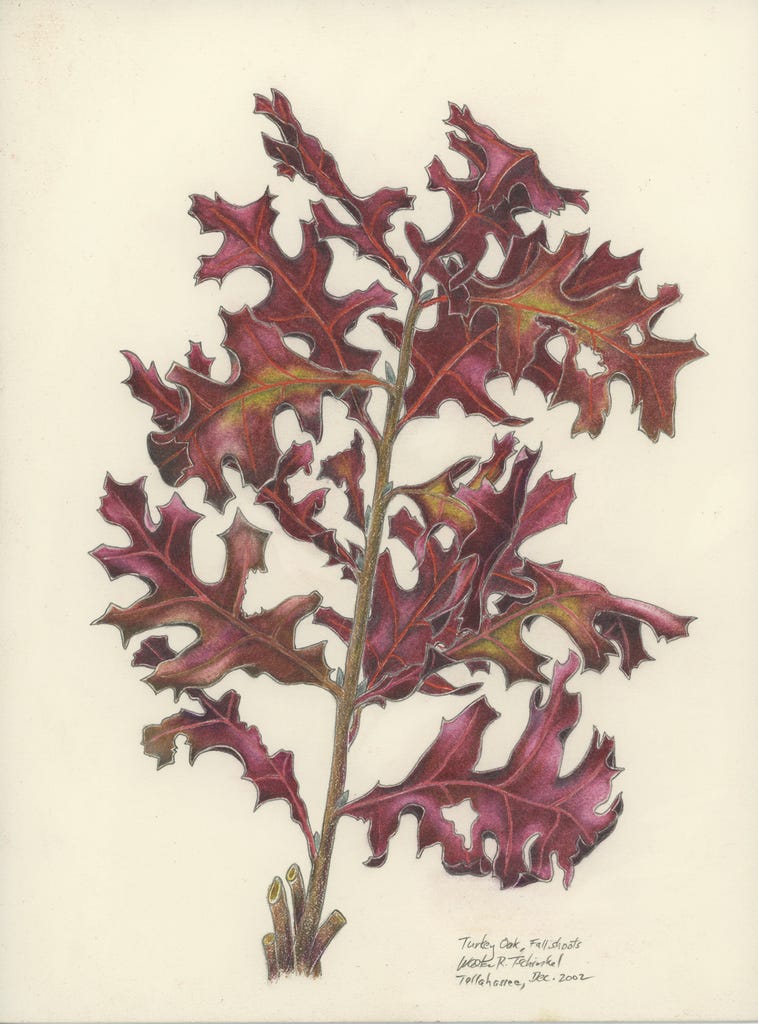One of the many weaknesses of humanity is an attraction to the magnificent and glorious, to the things that are three standard deviations above or below the mean. The ordinary, the common, humdrum, and work-a-day mostly escape our notice or get little respect. In the longleaf pine forests of the Florida coastal plain, most of the awe and adulation goes to the pines--- the older, more flat-topped and grizzled the better--- while the modest turkey oak gets scorn, ridicule, and hostility. It is the Also-Ran that foresters wish hadn't run at all, the tree that suggests there is something wrong in the ecosystem, specifically, not enough fire, and of course, not enough pines. Foresters hover over their longleaf pines jealously, like neurotic parents, so it is telling that they often encourage the public to butcher turkey oak at will for firewood.
Admittedly, compared to live oak or southern red oak, turkey oak is undeniably dinky and homely. You could even call it scruffy. It is a haphazard sort of tree, usually lacking a well-shaped crown, and it may be lopsided and unsymmetrical with a branch sticking out at an angle here and there. But it is a tree with a definite personality and strongly held preferences about where to grow, and you might even say it is persnickety, as it does not like to get its feet wet. When you see groves of turkey oak within the pine forest, you can be sure that the water table is at least one and a half meters below ground, so that in the flatwoods, turkey oak defines the high points (if they can be called that) in this gently undulating landscape. On a cloudless, sweaty, withering July afternoon in the piney woods, a shady grove of turkey oak is a welcome relief, a place to sit on the crackling fallen leaves, drink water and sweat quietly.
But homely as it may appear, sometimes turkey oak is so surpassingly, subtly beautiful and charming that is makes you pause in wonder. The gentle reddish blush that edges the soft unfolding pale green leaves in the spring as they expand into red-veined chartreuse, or the intense carmine of the winter shoots that poke up after a burn, all these fall pleasantly on the eye and mind. None of these are loud displays like the brash, in-your-face splash of a red rose or the blue flag of a domestic iris, but are shy, gentle kindnesses. Turkey oak speaks quietly to those who can listen, who enjoy a subtle conversation. I can't think of a more delightful way of saying hello to spring.






hi walter,
we're out here and we do love what u write and how u write it.
what a wonderful tribute to an oak i did not know of.
we have one oak living on our 40 acres. it all started when we picked up an acorn from the ground under a giant oak tree in a town park in nelson, BC. we brought it home (60 km as the crow flies) north of nelson. we potted it, then repotted a couple more times until we decided we'd "turn it loose". its living happily at the interface between dense hemlock and doug fir woods and our drive near our house. seems happy w/ water only. it chooses to display differently ea late fall--different colors, different timing or leaf fall and whether to drop leaves at all until mid winter. its a welcome bright spot against the deep green coniferous woods, whether in summer or fall.
Just wonderful! Writing, art, insight and wisdom! It's a marvelous essay and made a deep impression on me at least. I read somewhere, long ago, that the least valued things are precisely the things most valuable. I had a lopsided little plant in the backyard. Year after year it would emerge from the frozen ground and no matter how I watered it or applied fertilizers, it never rounded out or prospered but stubbornly persisted, barely clinging to life. It has been years since it's been at its place under the yellow rose, but I miss it dearly. Issa, the poet, had a similar plant. He mentions it in his Year of My Life.